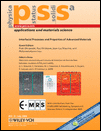Structural properties of quaternary InAlGaN MQW grown by plasma-assisted MBE
Abstract
Quaternary In0.085Al0.285Ga0.63N/GaN multiple quantum wells (MQW) grown by plasma-assisted molecular beam epitaxy are characterized by high resolution transmission electron microscopy (HRTEM), geometric phase analysis, and energy dispersive X-ray (EDX) nano-analysis. The MQW exhibit sharp well-defined InAlGaN/GaN interfaces while the GaN/InAlGaN interfaces are more smeared. The InAlGaN quantum wells and the GaN barriers are lattice-matched. Chemical distribution profiles are extracted from EDX line scans, obtained with a nanoprobe, which are compared to convoluted theoretical profiles, and are in good agreement with the HRTEM observations. Indium clustering occurs after prolonged observation under the electron beam. (© 2006 WILEY-VCH Verlag GmbH & Co. KGaA, Weinheim)




